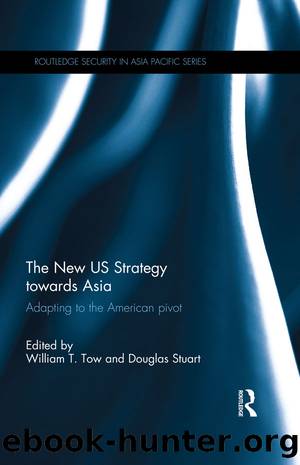The New US Strategy Towards Asia: Adapting to the American Pivot by William T. Tow & Douglas T. Stuart

Author:William T. Tow & Douglas T. Stuart [Tow, William T. & Stuart, Douglas T.]
Language: eng
Format: epub
Tags: Political Science, International Relations, General, Security (National & International), Social Science, Ethnic Studies
ISBN: 9781138822634
Google: FMAEoAEACAAJ
Goodreads: 22505931
Publisher: Routledge
Published: 2014-12-17T00:00:00+00:00
Part III
Southeast Asian partners and allies
8 Strategic communication
US-Philippines relations and the American rebalancing strategy
Charmaine G. Misalucha
From 2011, the Barack Obama Administration made a series of announcements that the United States was shifting its attention away from Iraq and Afghanistan and towards Asia (Obama 2011). This rebalancing, it has been argued, is a ânatural trendâ that focuses on the up-and-coming, dynamic region of the world (Cronin 2012: 12). At the same time, this new policy was seen as a counter-narrative to American decline, as well as a way to balance the rapid growth, strength and influence of China in the region (McDevitt 2012). While the strategy was multi-faceted, tensions in the South China Sea overshadowed its diplomatic and economic rationale and made it, at least insofar as the Philippines is concerned, âa decidedly military effortâ (Bitzinger 2012: 35, emphasis in original).
The American rebalancing strategy is much broader than a mere resuscitation of the US-Philippines security relationship. American strategic moves that are hallmarks of the rebalancing strategy include the deployment of 2,500 US Marines for training purposes in Darwin, the stationing of four new littoral combat ships at the Changi Naval Base in Singapore, plans for temporary basing access in the Philippines, and an increase in the number of ships in the Pacific Fleet. Such moves, however, do not definitively pin down the strategyâs overall meaning and content (Glosserman 2013). I argue that until that is accomplished, the US rebalancing strategy will remain cloaked in ambiguity.
Interestingly, despite the ambiguity surrounding the rebalancing strategy and its motivations, the United States has been able to implement successfully its basic concept. If we strip away the diplomatic, economic and military aspects of the rebalancing strategy, we are left with several basic premises: that the United States is âbackâ in the region, that it is prioritizing Asia, and that it has a stake in helping to shape the regionâs future security architecture. A good measure of the persuasiveness of this idea is not just that it was âsoldâ in a narrative that is both cohesive and shaped against the backdrop of an empirical reality, but also that it was âboughtâ by the Philippines, a renowned American treaty ally. The selling and buying of ideas in international relations is a paramount requirement for effective international security relations. In this case, that requirement seems well on its way to being fulfilled.
In this context, several questions are especially pertinent and will be considered in more detail below: how did the United States âsellâ the idea of a rebalancing strategy, and why did the Philippines âbuyâ it? The focus here is on the methods used in the transaction, not the evidence that a sale has actually taken place. The United Statesâ application of communication strategies â employed for framing the rebalancing concept â will be privileged over any quest to establish a causal link between the rebalancing strategy and a perceptible and tangible change in the beliefs and/or perceptions of the Philippines.
The reasons behind adopting this analytical framework of assessing communication strategies are twofold.
Download
This site does not store any files on its server. We only index and link to content provided by other sites. Please contact the content providers to delete copyright contents if any and email us, we'll remove relevant links or contents immediately.
What's Done in Darkness by Kayla Perrin(25493)
Shot Through the Heart: DI Grace Fisher 2 by Isabelle Grey(18209)
Shot Through the Heart by Mercy Celeste(18153)
The Fifty Shades Trilogy & Grey by E L James(17768)
The 3rd Cycle of the Betrayed Series Collection: Extremely Controversial Historical Thrillers (Betrayed Series Boxed set) by McCray Carolyn(13182)
The Subtle Art of Not Giving a F*ck by Mark Manson(12898)
Scorched Earth by Nick Kyme(11823)
Stepbrother Stories 2 - 21 Taboo Story Collection (Brother Sister Stepbrother Stepsister Taboo Pseudo Incest Family Virgin Creampie Pregnant Forced Pregnancy Breeding) by Roxi Harding(11019)
Drei Generationen auf dem Jakobsweg by Stein Pia(10211)
Suna by Ziefle Pia(10179)
Scythe by Neal Shusterman(9251)
International Relations from the Global South; Worlds of Difference; First Edition by Arlene B. Tickner & Karen Smith(8600)
Successful Proposal Strategies for Small Businesses: Using Knowledge Management ot Win Govenment, Private Sector, and International Contracts 3rd Edition by Robert Frey(8407)
This is Going to Hurt by Adam Kay(7682)
Dirty Filthy Fix: A Fixed Trilogy Novella by Laurelin Paige(6445)
He Loves Me...KNOT by RC Boldt(5798)
How to Make Love to a Negro Without Getting Tired by Dany LaFerrière(5369)
Interdimensional Brothel by F4U(5299)
Thankful For Her by Alexa Riley(5149)
